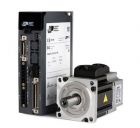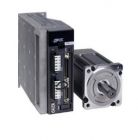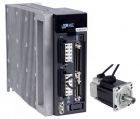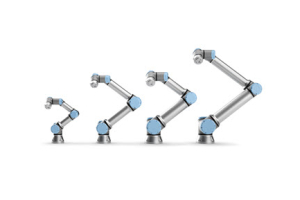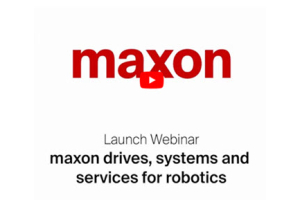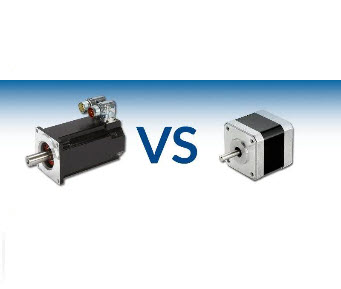
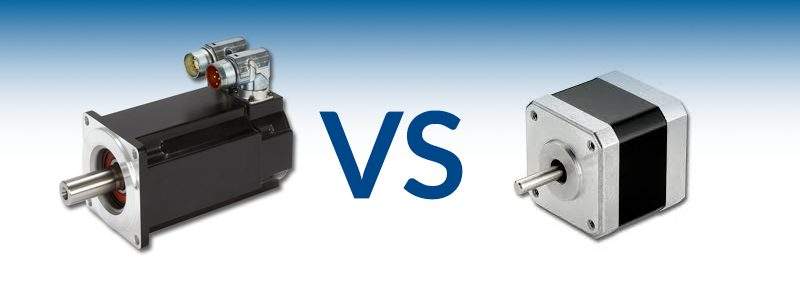

In this whitepaper, we will compare servo systems and stepper systems, which are commonly used in motion control applications. We will discuss the differences between them, their advantages and disadvantages, the industries/applications where each excels, and a brief historical timeline of each.
Servo systems:
Servo motors typically consist of a stator and a rotor. The stator is a stationary component that contains three-phase windings. The rotor is a rotating component that contains permanent magnets or electromagnets. The windings in the stator create a rotating magnetic field that interacts with the magnets in the rotor to produce torque.
A servo drive controls the current supplied to the motor windings to achieve precise control over speed, position, and torque. The servo drive uses a closed-loop control system, which compares the actual position and velocity of the motor shaft to the desired position and velocity and adjusts the current supplied to the motor windings accordingly. This closed-loop control system enables high precision and accuracy in motion control applications.
A feedback device is an essential component of a servo system. It provides information about the position and velocity of the motor shaft and enables the servo drive to adjust the current supplied to the motor windings to achieve precise control over speed, position, and torque. Common types of feedback devices used in servo systems include encoders, resolvers, and potentiometers.
Encoders are the most common feedback devices used in servo systems. They provide high-resolution position and velocity information and are available in different types such as absolute and incremental encoders. Absolute encoders provide the position of the shaft at any given time, while incremental encoders provide the change in position between two points in time.
Resolvers are another type of feedback device used in servo systems. They are like encoders but use a different sensing technology. Resolvers are more robust and durable than encoders and can operate in harsh environments with high temperatures and vibrations.
Potentiometers are the simplest type of feedback device used in servo systems. They provide an analog signal proportional to the position of the motor shaft and are suitable for low-precision applications.
Industries and Applications Servo Systems Excel in:
- Robotics and automation: Servo systems provide high precision and accuracy for precise motion control in robotic applications.
- CNC machines: Servo systems enable rapid acceleration and deceleration for high-speed machining operations.
- Printing and packaging: Servo systems enable precise control over position and velocity for accurate printing and packaging operations.
- Aerospace and defense: Servo systems provide high performance and reliability in aerospace and defense applications.
- Medical devices: Servo systems enable precise control over motion and force for medical devices such as surgical robots.
- Semiconductor manufacturing: Servo systems provide precise control over position and velocity for semiconductor manufacturing processes.
Stepper systems:
A stepper system consists of a stepper motor and a stepper drive. Stepper motors consist of a stator and a rotor. The stator contains a series of poles, which are made up of stacked laminations that form a cylindrical shape. Each pole has a winding that is connected to a stepper drive. The rotor contains a series of teeth that are also made up of stacked laminations. The teeth are arranged in a specific pattern and are magnetized to form a north or south pole.
The interaction between the magnetic fields generated by the stator poles and the rotor teeth produces torque, which causes the rotor to rotate. The number of poles and teeth in the stepper motor determines the number of steps per revolution. Stepper motors are operated by sending current pulses to the motor windings in a specific sequence. The sequence of pulses determines the direction and speed of the motor, and the number of pulses determines the distance moved.
There are several different sequence patterns that can be used to drive stepper motors. The most common sequence patterns are full-step, half-step, and microstepping. Full-step sequences energize only one winding at a time, while half-step sequences energize two windings at a time. Microstepping sequences energize the windings in a sequence that produces small incremental movements, allowing for smoother motion and higher resolution.
Open-loop control algorithms are commonly used in stepper systems to determine the sequence of pulses sent to the motor windings. These algorithms do not rely on feedback from a position sensor and are less complex than closed-loop control algorithms used in servo systems. The simplest open-loop control algorithm is the "step and direction" control algorithm, which uses two digital signals to control the motor. The "step" signal sends a pulse to the motor winding to move it one step, while the "direction" signal determines the direction of rotation.
More advanced open-loop control algorithms use microprocessors or digital signal processors (DSPs) to calculate the optimal sequence of pulses to achieve precise control over position and velocity. These algorithms take into account factors such as acceleration, deceleration, and load characteristics to optimize motor performance.
Stepper motors use a simple and reliable construction based on the interaction between the magnetic fields of the stator poles and rotor teeth to produce torque. Open-loop control algorithms are used to determine the sequence of pulses sent to the motor windings to achieve precise control over position and velocity in discrete steps, without the need for a feedback device. The simplicity and low cost of stepper motors and their open-loop control algorithms make them suitable for a wide range of applications, particularly in light-load, low-precision applications where cost and simplicity are important factors.
Examples if Industries and Applications Stepper Systems Excel in:
- 3D printing and prototyping: Stepper systems provide precise and repeatable motion control for 3D printing and rapid prototyping applications.
- Textile manufacturing: Stepper systems enable precise control over the movement of fabrics in textile manufacturing operations.
- Robotics and automation (for light-load applications): Stepper systems are often used in light-load robotic applications where cost and simplicity are important.
- Home and office automation: Stepper systems are used in a variety of home and office automation applications such as motorized blinds and curtains.
Comparing Systems:
Advantages of Servo Systems:
- High precision and accuracy: Servo systems use feedback devices to provide precise control over position and velocity. This allows for high precision and accuracy in motion control applications.
- Smooth and precise control over speed, position, and torque: Servo systems can provide smooth and precise control over speed, position, and torque due to their closed-loop control system.
- Handles high loads: Capable of handling high loads due to their high torque output.
- High dynamic performance and responsiveness: Servo systems can respond quickly to changes in position or velocity commands, allowing for high dynamic performance.
- Low electrical noise and heat generation: Servo systems generate less electrical noise and heat compared to stepper systems due to their closed-loop control system.
- Can operate at high speeds: Servo systems can operate at high speeds due to their high dynamic performance and responsiveness.
Disadvantages of Servo Systems:
- Higher cost: Servo systems are typically more expensive compared to stepper systems due to their more complex construction and requirement for feedback devices.
- More complex to set up and tune: Servo systems require more setup and tuning compared to stepper systems due to their closed-loop control system.
- Require a feedback device for accurate control: Servo systems require a feedback device to achieve accurate control over position and velocity.
Advantages of Stepper Systems:
- Lower cost compared to servo systems: Stepper systems are typically less expensive compared to servo systems due to their simpler construction and lack of feedback devices.
- Simpler to set up and operate: Stepper systems are easier to set up and operate compared to servo systems due to their open-loop control system.
- No need for a feedback device: Stepper systems do not require a feedback device to achieve accurate control over position and velocity.
- Can provide high torque at low speeds: Stepper systems can provide high torque output at low speeds due to their open-loop control system.
Disadvantages of Stepper Systems:
- Lower precision and accuracy compared to servo systems: Stepper systems have lower precision and accuracy compared to servo systems due to their open-loop control system.
- Limited dynamic performance and responsiveness: Stepper systems have limited dynamic performance and responsiveness due to their open-loop control system.
- Limited speed and acceleration: Stepper systems have limited speed and acceleration compared to servo systems due to their open-loop control system.
- Higher electrical noise and heat generation: Stepper systems generate more electrical noise and heat compared to servo systems due to their open-loop control system.
- Not suitable for high loads: Stepper systems are not suitable for high-load applications due to their limited torque output.
Comparison Chart:
The advantages and disadvantages of servo and stepper systems arise from their construction, control systems, and feedback requirements.
By understanding these factors, engineers can select the appropriate motor system for their application based on factors such as cost, precision, speed, and load capacity.
| Criteria | Servo Systems | Stepper Systems |
|---|---|---|
| Cost | Higher | Lower |
| Precision | Higher | Lower |
| Control | Smooth and precise | Discrete and step-based |
| Feedback | Required | Not required |
| Torque at low speeds | Limited | High |
| Dynamic performance | High | Limited |
| Speed and acceleration | High | Limited |
| Electrical noise and heat generation | Low | High |
| Load capacity | High | Low |
| Holding position without power | Not suitable | Suitable |
| Applications | High-precision and high-speed positioning, rapid acceleration and deceleration, tight synchronization and coordination between multiple axes | Low-precision positioning, slow speed and acceleration, holding position without power, light-load applications |
| Industries | Robotics and automation, CNC machines, printing and packaging, aerospace and defense, medical devices, semiconductor manufacturing | 3D printing and prototyping, textile manufacturing, robotics and automation (for light-load applications), home and office automation |
Historical Timeline:
Servo Systems:
- 1940s: The first servo motors were developed for industrial automation, enabling more precise control over position and velocity.
- 1960s: The first closed-loop servo systems were introduced, which used feedback devices such as resolvers or encoders to improve control accuracy. One example is the Honeywell TDC 2000 system, which used a digital signal processor to control servomotors in industrial applications.
- 1980s: The first digital servo drives were introduced, which enabled more precise and flexible control over speed and torque.
- 2000s: Servo systems became more compact, energy-efficient, and cost-effective.
Stepper Systems:
- 1830s: The first stepper motor was developed by William Sturgeon, which used electromagnets to rotate a shaft in small steps. This early motor was used in scientific instruments and telegraph equipment.
- 1910s: The first commercial stepper motors were introduced, which used DC current to drive the motor.
- 1960s: The first modern stepper motors were introduced, which used permanent magnets and improved control algorithms.
- 1980s: The first microstepping drives were introduced, which enabled smoother and more precise motion control.
- 2000s: Stepper systems became more advanced and affordable, with improved control electronics and higher torque.
Did you know??
- The first servo mechanism was developed by Elmer Sperry in the early 1900s for use in ships. It was used to automatically control the steering of a ship, making it easier for the operator to maintain course in rough seas.
- The word "servo" comes from the Latin word "servus," which means "slave" or "servant." In the context of servo systems, the term refers to the way the motor follows the commands of the controller.
- The first commercial servo drive was introduced in the 1960s by Kollmorgen Corporation, one of the leading manufacturers of servo systems.
- Servo motors are used in the entertainment industry to control the movements of animatronic figures in theme parks and other attractions. This allows for lifelike movements and interactions with visitors.
- The use of servo systems in the automotive industry has led to the development of advanced driver-assistance systems (ADAS) that use sensors and cameras to help drivers stay in their lanes and avoid collisions.
- Servo systems are used in the medical industry to control the movements of robotic surgical tools, allowing for precise and minimally invasive procedures.
- The first stepper motor was invented by Charles Batchelor in 1864 as part of a telegraph system. It was used to automatically send messages over telegraph wires.
- Stepper motors were first used in industrial applications in the 1950s to control the movements of assembly line machines.
- Stepper motors are commonly used in 3D printers to control the movements of the print head and build platform. This allows for precise control over the print process and the ability to create complex shapes and structures.
- Stepper motors are used in CNC machines to control the movements of the cutting tool, allowing for precise and repeatable cuts in materials such as metal and wood.
- Stepper motors are used in telescope tracking systems to control the movements of the telescope as it tracks celestial objects. This allows for precise tracking of objects in the sky and the ability to capture detailed images.
Servo and stepper motor systems have distinct advantages and disadvantages that make them suitable for different applications. By understanding the differences in their construction, control systems, and feedback requirements, engineers can select the appropriate motor system for their application based on factors such as cost, precision, speed, and load capacity.
Electromate, a leading supplier of high-performance servo and stepper solutions, offers a wide range of products and expertise to help engineers choose the optimal motor system for their application. With over 30 years of experience in the industry, Electromate offers not only the latest products from leading manufacturers but also technical support and engineering services to help customers get the most out of their motor systems. Whether you're looking for a high-precision servo system for a demanding manufacturing application or a low-cost stepper system for a simple automation task, Electromate has the expertise and products to meet your needs.

